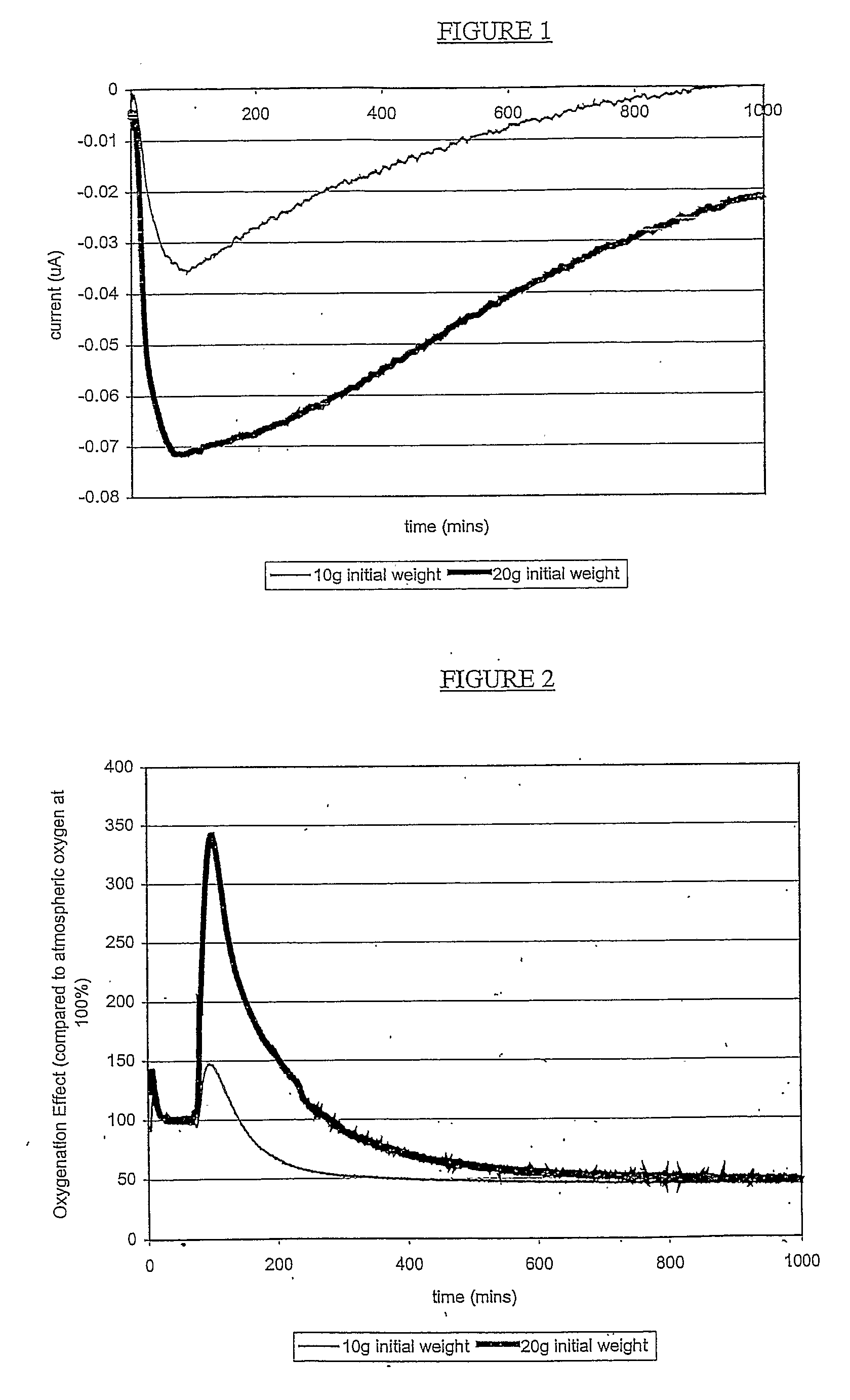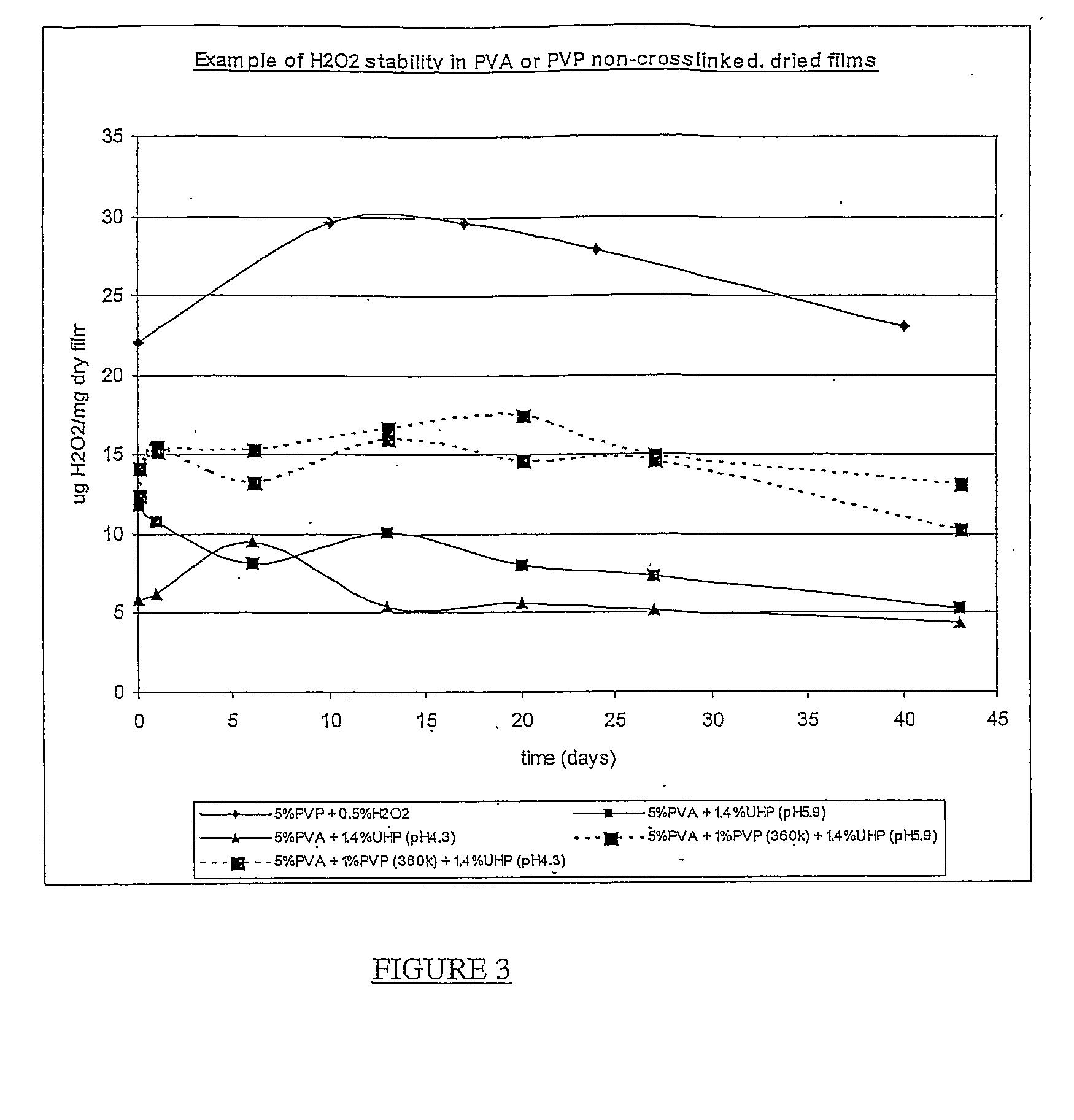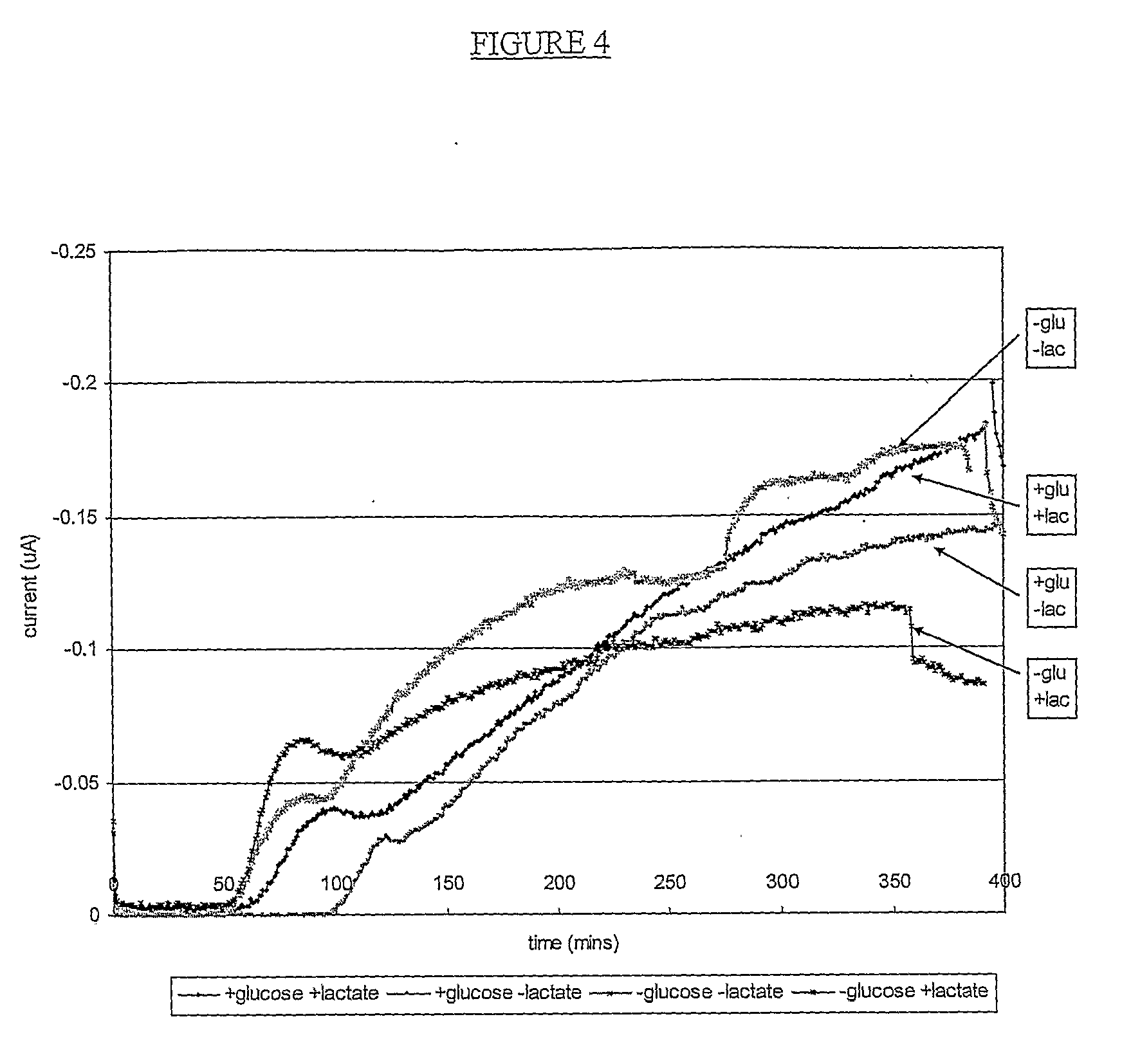Hydrogen Peroxide Delivery System
a hydrogen peroxide and delivery system technology, applied in the field of delivery systems, can solve the problems of excessive hydrogen peroxide toxic to tissue cells, too great potential toxicity to justify regular application to skin or open wounds, and short life, so as to reduce the rate at which hydrogen peroxide is made available, effectively expose the wound to oxygen, and avoid toxic effects on the wound tissue
- Summary
- Abstract
- Description
- Claims
- Application Information
AI Technical Summary
Benefits of technology
Problems solved by technology
Method used
Image
Examples
example 1
[0058]Polyvinyl alcohol (PVA) (98-99% hydrolysed, 124,000-186,000 molecular weight, code 36, 316-2 from Aldrich) was dissolved in de-ionised water to a final concentration of 5% w / w. The water was heated to boiling point, and the PVA granules were slowly added, with constant agitation. The water temperature was maintained at 80° C. or above, until the PVA had dissolved. The PVA solution was allowed to cool to room temperature about (21° C.) before use.
[0059]Urea-Hydrogen Peroxide (UHP) (containing 35% hydrogen peroxide, code U1753 from Sigma) was added to the 5% PVA solution, to give 1.0% w / w. This gave a final PVA concentration 4.95% w / w. The UHP was readily soluble, and only slight agitation at RT (21° C.) was required to dissolve the powder.
[0060]To form the dry films, constituting an upper component, a plastic container with a surface area of 124 cm2 was used. Into this, either 10 or 20 grams of the UHP / PVA solution was poured. The UHP / PVA solutions were spread evenly over the e...
example 2
[0071]5% w / w PVA solution was prepared as described in Example 1.
[0072]5% w / w PVP solution was prepared by dissolving 5 g PVP (360,000 average molecular weight, Sigma Code PVP360) in 95 g DI water. The PVP is cold water soluble and does not require any further treatment.
[0073]Using these stock solutions, the following were prepared:
[0074]Sample 1: to 5% PVP solution, water was added to give 0.5% w / w. Final [PVP]=4.92% w / w.
[0075]Sample 2: to 5% PVA solution, UHP was added to give 1.4% w / w. Final [PVA]=4.93% w / w. pH=5.9.
[0076]Sample 3: as sample 2, but pH adjusted with small volume of citric acid to give pH 4.3.
[0077]Sample 4: to 5% PVA solution, UHP was added to give 1.4% w / w, and PVP was added to give 1% w / w. Final [PVA]=4.88%. pH=5.9.
[0078]Sample 5: as sample 4, but pH adjusted with small volume of citric acid to give pH 4.3.
[0079]10 g of each sample was dispensed into an 8.4 cm diameter petri dish, and dried at 40° C. for 18 hours. Samples 2-5 were then stored in a desiccator at R...
example 3
[0083]5% w / w PVA solution was prepared as described in Example 1.
[0084]PVP (360,000 average molecular weight, Sigma Code PVP360) and H2O2 (30% w / w, Sigma Code H1009) were added to the 5% PVA solution to give final concentrations of 1% and 0.5% respectively. PVA final concentration was 4.85%. 20 g of this mix was poured into a 10 cm2 dish and dried at 40° C. for 16 hours.
[0085]Secondary hydrogel layers were prepared using the following formulations:
ReagentGel 1Gel 2Gel 3Gel 4Water (ex Fisher, distilled, de-ionised, analytical grade)64.7%67.8%69.7%69.8%Sodium AMPS (ex Lubrizol AMPS 2405 Monomer)30.0%30.0%30.0%30.0%Polyethylene glycol diacrylate (PEG700 diacrylate, ex0.19%0.19%0.19%0.19%Aldrich - 455008) (a cross-linker)1-hydroxycyclohexyl phenyl ketone (ex Aldrich - 40,561-2)0.01%0.01%0.01%0.01%(a photoinitiator)Anhydrous glucose, (ex Fisher, analytical grade, code5.00%5.00% 0% 0%GO50061)Potassium iodide (ex Fisher, analyical grade, P584050)0.05%0.05%0.05%0.05%Zinc L-lactate hydrate...
PUM
| Property | Measurement | Unit |
|---|---|---|
| thickness | aaaaa | aaaaa |
| thickness | aaaaa | aaaaa |
| diameter | aaaaa | aaaaa |
Abstract
Description
Claims
Application Information
 Login to View More
Login to View More - R&D
- Intellectual Property
- Life Sciences
- Materials
- Tech Scout
- Unparalleled Data Quality
- Higher Quality Content
- 60% Fewer Hallucinations
Browse by: Latest US Patents, China's latest patents, Technical Efficacy Thesaurus, Application Domain, Technology Topic, Popular Technical Reports.
© 2025 PatSnap. All rights reserved.Legal|Privacy policy|Modern Slavery Act Transparency Statement|Sitemap|About US| Contact US: help@patsnap.com



